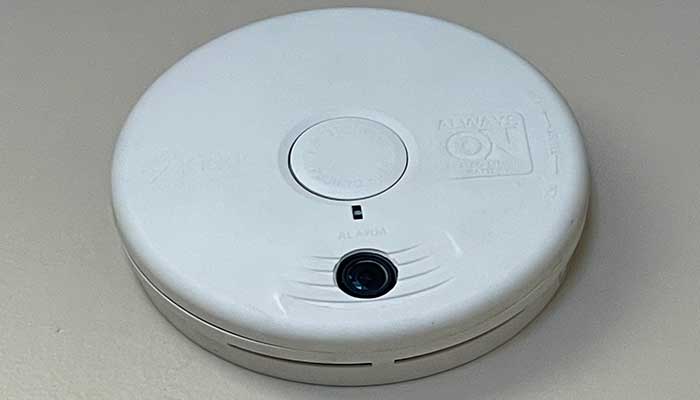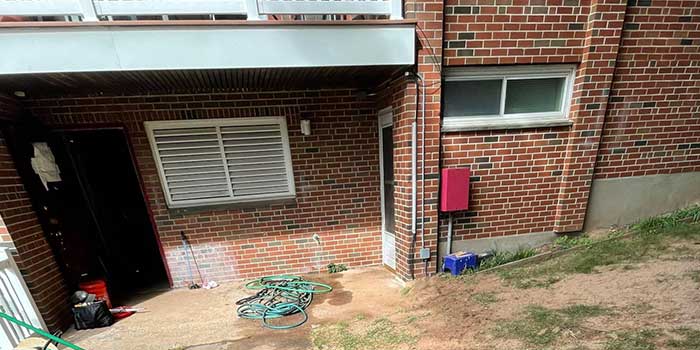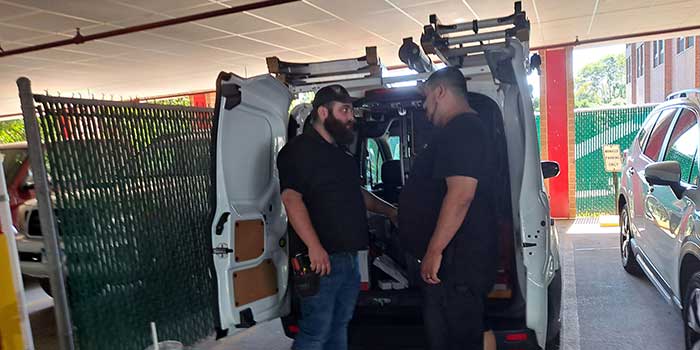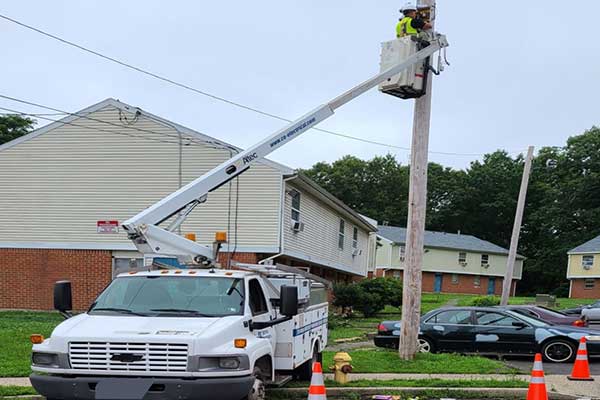Video MGMT System
 Access Control
Access Control
Voice & Data Wiring
 Burglar Alarm
Burglar Alarm
 Fire Alarm
Fire Alarm
Video MGMT System
Voice & Data Wiring
Too busy to read the whole article? Here's a short bullet-point summary:
Hello, fellow safety enthusiasts! As your go-to provider for advanced security systems, our team at Mammoth Security loves digging into the nitty-gritty of all things security!
Today, let's step into the world of those unassuming wall-mounted devices, carbon monoxide detectors. We'll find out why CO is dangerous and unravel the mystery of how CO detectors work.

Carbon monoxide (CO) is an odorless gas produced by fuel-burning appliances. It's dangerous because it binds more readily to red blood cells than oxygen does, preventing the body from using the oxygen it needs to function.
CO poisoning symptoms often mimic the flu, making it difficult to diagnose. Symptoms include headache, fatigue, shortness of breath, nausea, and confusion. More severe exposure can lead to vomiting, loss of consciousness, and death.
Carbon monoxide poisoning occurs when CO molecules bind to hemoglobin in blood to form carboxyhemoglobin, which prevents oxygen from being effectively transported throughout your body. This can lead to symptoms such as headache, dizziness, weakness, upset stomach, chest pain, confusion, and death.
The Centers for Disease Control (CDC) reports that carbon monoxide poisoning is responsible for over 400 deaths annually in the U.S., and even low concentrations of CO can cause carbon monoxide poisoning.
The gas is nearly impossible to detect without a carbon monoxide detector, making these devices critical life-saving tools.
You can think of CO as a weird aunt at a family potluck—a weird aunt who, incidentally, has poisoned her delicious casserole to watch everyone pass out and die! Yikes!
While we can't say much about the deadly poisons in your aunt's casserole, we do know a lot about CO and what it does to human beings.
Carbon monoxide binds to hemoglobin in red blood cells, forming carboxyhemoglobin. This binding displaces oxygen that would normally bind with hemoglobin, thus causing hypoxia. This condition results from reduced oxygen supply to tissues, which can occur as a result of carbon monoxide exposure.
Carbon monoxide poisoning describes the overall state of the body when carbon monoxide reduces the blood's oxygen-carrying capacity. Symptoms of CO poisoning range from headaches and dizziness to unconsciousness and death, depending on the severity of the exposure.
Carbon monoxide detectors are designed to sense dangerous levels of CO. Once a dangerous amount of carbon monoxide enters the CO detector's chamber, its alarm sounds to alert everyone of potential danger.

If your carbon monoxide alarm goes off, immediately evacuate to fresh air and call emergency responders.
Determine if anyone is exhibiting symptoms of CO poisoning, which include headache, fatigue, confusion, shortness of breath, nausea, vomiting, and loss of consciousness. If anyone is, mention this when you call for help.
Electrochemical sensors are the most commonly used method for CO detection because of their high sensitivity to CO and their low rate of false alarms. They operate using an electrochemical cell, which can be thought of as a tiny battery. Inside the cell, a platinum electrode is immersed in a chemical electrolyte along with another electrode made of metal.
When carbon monoxide enters through the detector’s vents, it undergoes a reaction with the platinum electrode, releasing ions. This, in turn, generates an electric current proportional to the amount of CO in the air, which triggers the alarm when the concentration of CO exceeds a certain threshold.
MOS detectors employ a different mechanism. They consist of a silica chip with a circuit that is heated to a high temperature, usually around 400 degrees Celsius. This heat transforms the tin dioxide semiconductor on the chip’s surface into a conductive material.
When CO gas encounters this surface, it reduces the semiconductor's resistance, causing an increase in electrical flow through the circuit. This change is sensed and processed, and if the increase is above a certain level, the alarm is triggered.
This sensor type is extremely durable and commonly installed in environments requiring resistance to humidity and temperature changes.
A less common but still effective type of CO detector is the biomimetic sensor. These detectors use gel-based, color-changing disks that mimic hemoglobin's reaction to carbon monoxide in the human body.
When CO is present, the gel changes color and this change is detected by a light sensor. If the color change is sufficient, the alarm is activated.
A buildup of carbon monoxide occurs primarily due to improper ventilation, faulty heating systems, and gas-burning appliances, including water heaters and kerosene heaters. Portable generators and vehicle exhaust are other sources.
If appliances aren't correctly installed or maintained, they can produce dangerously high levels of CO.
CO becomes hazardous at concentrations above 70 parts per million (ppm) for sustained periods. Even short-term exposure to levels above 150 to 200 ppm can lead to disorientation, unconsciousness, and even death.

The experience and expertise of professional installation teams is crucial for ensuring sensor placement that will reliably reduce the risk of CO poisoning.
A professional can provide a site survey and assessment that considers the size of your property and the number of potential CO sources that need to be monitored. A professional installer from Mammoth Security will know where to place detectors to ensure complete coverage.
Professionals also are up-to-date on local laws and regulations. For example, experts like those on the Mammoth Security team follow the National Fire Protection Association's recommendation that installers place carbon monoxide detectors on every level of a property, including the basement.
Like any device, carbon monoxide detectors need regular maintenance and testing to ensure their effectiveness. Professionals recommend testing the device monthly and replacing batteries yearly or as needed.

At Mammoth Security, we understand that safety is paramount. You can trust us for all your CO detector needs, from selection and installation to regular maintenance, ensuring a safer home environment against the silent killer. To learn more or schedule a free assessment with an expert from our team, fill out the simple blue form below.
NOT COMPLETELY SURE?
860-748-4292This may indicate a low battery or an end-of-life warning. Refer to the manufacturer's instructions or contact Mammoth Security for assistance.
The ppm reading indicates the concentration of carbon monoxide in the air. Levels above 70 ppm are potentially dangerous.
Yes, but professional installation is recommended to ensure optimal placement and compliance with local laws and regulations.
Most manufacturers recommend replacing carbon monoxide detectors every 5-7 years but check your manufacturer's instructions or ask a professional during a fire alarm inspection.
CO detectors should be installed on every level of your home, in sleeping areas, and near fuel-burning appliances.
Carbon monoxide (CO) is an odorless, colorless, and tasteless gas, often referred to as the "silent killer." It's produced by incomplete combustion from various sources like fuel-burning appliances, heating systems, and vehicle exhaust.
A CO detector is a crucial piece of safety equipment that alerts homeowners to dangerous concentrations of carbon monoxide in the home. It uses biomimetic, metal oxide, or electrochemical sensors to detect carbon monoxide molecules in the air. If the CO concentration reaches dangerous levels, the alarm sounds, giving you a chance to evacuate and address the CO leak.
Carbon monoxide poisoning can cause flu-like symptoms, confusion, dizziness, and headaches, and in extreme cases, it can be fatal. CO poisoning is a serious risk as CO binds with the hemoglobin in your red blood cells, preventing them from carrying oxygen around your body.
Install carbon monoxide detectors near bedrooms and living spaces and regularly check and replace them as per the manufacturer's instructions. Also, ensure proper ventilation, especially around fuel-burning appliances like gas-burning appliances, heating systems, and water heaters. Regular maintenance of these appliances can also prevent the build-up of carbon monoxide.
Carbon monoxide is typically produced by fuel-burning appliances such as furnaces, water heaters, stoves, and portable generators. Even vehicle exhaust can produce CO.
According to the National Fire Protection Association, CO concentrations should be less than nine parts per million (ppm), with no CO alarms triggering for at least 30 days when levels are under 30 ppm.
Most carbon monoxide alarms have a lifespan of around 5-7 years, but this can vary between brands. Check the manufacturer's instructions for exact details. Remember, a well-functioning CO detector is an essential part of your home security system.
Carbon monoxide detectors should be installed in central locations, like the hallway adjacent to bedrooms, to ensure the alarm is audible. They can be plugged into an outlet, hardwired, or battery-powered. Make sure to follow the manufacturer's instructions or local laws while installing.
When your CO alarm sounds, immediately move to fresh air outdoors or by an open window or door. Ensure everyone inside the home is accounted for, call for help from the fresh air location, and stay there until emergency responders declare that it is safe to reenter the home.
CO detectors should be placed on every level of your home, including the basement. Install additional detectors within 10 feet of each bedroom door and near all sleeping areas. If you have a fuel-burning appliance, fireplace, or attached garage, install a CO detector in these areas.